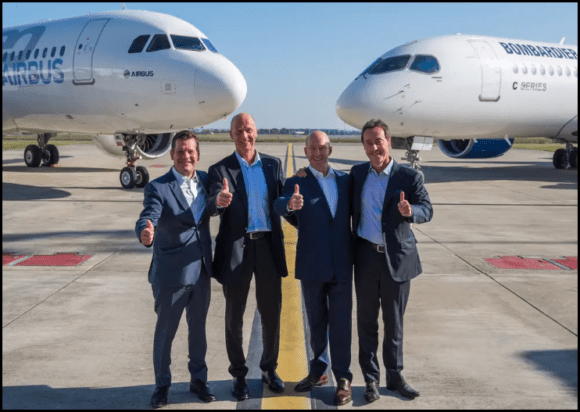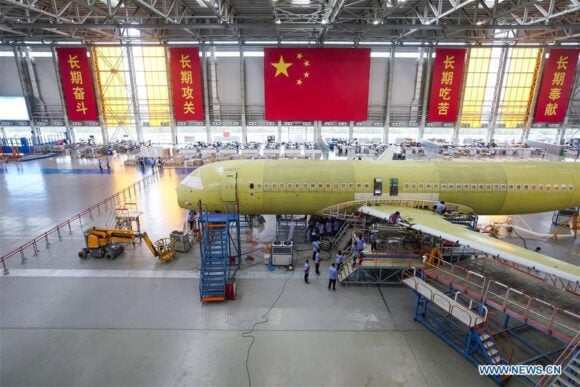
American Boeing757
With the July numbers published, here’s our updated model keeping the Duopoly score.
The recovery at Boeing is gathering pace, much to the relief of the entire supply chain and Airbus. Of special relief is China taking its long-parked MAXs. There’s no downside here. But there’s a backstory that needs to be told.
The A320 vs the 737
There is an item that warrants mention. Bloomberg has this interesting story on how the A320 is about to eclipse the 737. This data point had been noted some weeks ago by Cirium. It is a milestone event for sure.
But we want to point out that the story is much more than about the A320 vs the 737. There’s an important nuance.
In the model above, click on Single and MOM. This selects single-aisle aircraft and Middle of Market models. Essentially, the 757, 737-900, MAX 9, and A321s. Now look at the Airbus vs Boeing trends. The swing is dramatic.
The dramatic picture highlights Boeing’s massive strategic error in not replacing the 757. The market upsized, and the MAX 9 does not effectively compete with the A321. The better competitor would be the MAX 10, and that remains to be certified. There’s a story here, and ownership of this mistake goes back a long way and has many owners.
The upsizing term is key: Boeing talked about “upsizing” in the context of the 757 replacement / NMA studies. Dennis Muilenburg often framed the NMA as “more than a 757 replacement.” He said the concept would “build upon the 757, but also cover part of the 767 market” — effectively an upsize from a 757.
The Post 757 Debacle
The decision not to replace the 757 has been a significant point of contention within the industry, reflecting changing market dynamics and internal corporate strategies. Initiated under the leadership of former CEO Jim McNerney, the discontinuation of efforts to develop a successor to the iconic aircraft has been attributed to the 757’s high production costs. But there was a shifting focus towards larger, more versatile aircraft to meet the evolving needs of airlines.
This strategic pivot underscored Boeing’s response to contemporary market realities, where demand for MOM aircraft is increasingly intertwined with the need for enhanced performance and operational efficiency. The implications of this decision are profound, affecting Boeing’s competitive position in the single-aisle segment, as the chart illustrates. Airbus gains traction with the growing A321 family, most recently with the A321XLR.
Analysts have voiced concerns that Boeing’s failure to introduce a new aircraft could result in a loss of market share, jeopardizing the company’s long-term viability in an industry marked by rapid technological advancement and shifting consumer preferences. Analysts have been discussing this for over a decade, also here and here. Indeed, the cost of Boeing’s focus on shareholder returns rather than investing in better products is plain to see.
The decision to forego a 757 replacement raised questions about Boeing’s commitment to innovation and its ability to respond to customer needs in a post-pandemic context, with airline and lessor executives expressing disappointment over the lack of a clear roadmap for new product development. Betting on the MAX has not turned out to be the low-cost winning solution it was hoped to be.
The absence of a 757 replacement sparked discontent among customers but also had broader implications for the supply chain and workforce development in aerospace manufacturing regions. The supply chain’s bias in favor of Airbus was inevitable as the market moved to the ever-improving A321 family’s capabilities.
Boeing is still navigating the fallout from this strategic choice, and the need for a revised approach to better align with market expectations is increasingly critical to its future success. But now there’s the resource crunch. Current estimates for a new program are $30 billion. That cost rises every year. Hence, Boeing’s determination to move every parked MAX into the market has led some stuck Chinese MAXs to find new homes in India. The race to build cash and pay down debt is part of the need to create that resource pool for the inevitable next program.
Summary
In summary, the decision not to replace the 757 reflects broader strategic challenges within Boeing, highlighting the tension between immediate financial performance and long-term innovation. As the company faces mounting pressure from both Airbus and customers, its ability to adapt and redefine its product offerings will be pivotal in resecuring its position as a leader in the aviation market.
While the 757 decision started with Jim McNerney, it was followed by Dennis A. Muilenburg and Dave Calhoun. That strategic error has several owners besides these former CEOs.
The MAX is performing well, but the absence of the MAX 10 hurts Boeing. Meanwhile, Airbus does not need to discount the A321 as it would were the MAX 10 in operation. Kelly Ortberg’s team has its work cut out, and fortunately, the path they need to navigate is clear.
Views: 590




